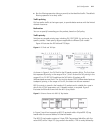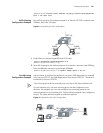
QoS Configuration 225
Configuring Queue Scheduling
The switch supports eight outbound queues at a port and it puts the packets into
the queues according to the local precedence of packets. Queue scheduling is
used to resolve problems of resource contention by many packets. The switch
supports SP algorithm and WRR algorithm.
Different outbound queues at the port can use different algorithms. The switch
supports three scheduling modes:
■ All-SP scheduling
■ All-WRR: The outbound queues are divided into WRR queue 1 and WRR queue
2. The switch first schedules the queues in the WRR queue1. If no packets are
waiting for being forwarded in WRR queue 1, then it begins to schedule the
queues in WRR queue 2. By default, all queues at a port are in WRR queue 1.
■ SP plus WRR: The outbound queues are put into different scheduling groups.
An SP group uses SP algorithm, WRR groups use WRR algorithm. The select
one queue respectively from SP group, WRR group 1 and WRR group 2 and
schedule them using the SP algorithm.
Perform the following configurations in Ethernet interface view.
By default, the switch uses all-SP mode, so those queues not configured with WRR
algorithm are SP mode.
See the Switch 8800 Command Reference Guide for details of the commands.
Configuring WRED Parameters
When there is network congestion, the switch drops packets to release system
resources so no packets are put into long-delay queues.
The switch allocates drop precedence for it when receiving a packet (also called
coloring the packet). The drop precedence values range from 0 to 2, with 2 for
red, 1 for yellow and 0 for green. In congestion, red packets will be first dropped,
and green packets last.
You can configure drop parameters and thresholds by queue or drop precedence.
The following two drop modes are available:
■ Tail drop mode: Different queues (red, yellow and red) are allocated with
different drop thresholds. When these thresholds are exceeded respectively,
excessive packets will be dropped.
■ WRED drop mode: Drop precedence is taken into account in drop action.
When only min-thresholds of red, yellow and green packets are exceeded,
excessive packets are dropped randomly at given probability. But when
Table 19 Configuring Queue Scheduling
Operation Command
Configuring queue scheduling queue-scheduler wrr { group1 { queue-id
queue-weight } &<1-8> | group2 { queue-id
queue-weight } &<1-8> }*
Restore the default setting undo queue-scheduler [ queue-id ] &<1-8>


















